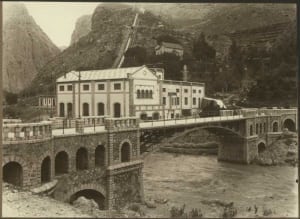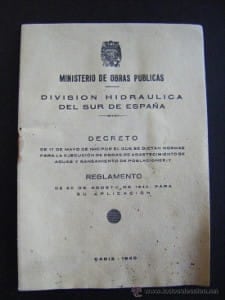El Chorro Reservoir Malaga or Conde de Guadalhorce Reservoir
Rafael Benjumea Burín was the author of the project for the El Chorro Reservoir or Conde de Guadalhorce Dam. Those who know the dam will understand perfectly why his contemporaries called Benjumea “the poet engineer“. His works were described as genius because in them he combined the functionality of an engineering work with respect for the natural environment, harmonizing utility with the beauty of the workmanship.
The praises of the beauty of the reservoir reached the ears of King Alfonso XIII, who paid an official visit on May 21, 1921. The king was so impressed by what he saw that in September of the same year he granted Rafael Benjumea the title of Count of Guadalhorce, “for himself, his children and legitimate successors“.
But before we got here, a lot of things had happened….
At the beginning of the 20th century, Malaga’s electricity supply depended on two foreign companies, which were able to manufacture electricity with steam engines. Two of the main families of the industrial bourgeoisie of Malaga, the Loring and the Heredia, related to each other, were the protagonists of a business initiative that culminated in the construction of the El Chorro Reservoir, called Embalse del Conde de Guadalhorce since 1953.
It was precisely the first Count of Guadalhorce, the engineer Rafael Benjumea Burín, who understood that the industrial development of the province required the construction of a power plant capable of producing enough electricity.

 Rafael Benjumea was married to Isabel Heredia Loring, whose cousin, Jorge Loring Heredia had obtained in 1901 the concession for the hydroelectric exploitation of the Guadalhorce River. In 1903, Jorge Loring, Rafael Benjumea and Francisco Silvela (also married to a Loring Heredia), founded the Sociedad Hidroeléctrica de El Chorro, with a capital of two million pesetas, whose purpose was the production of energy without the dependence of any foreign capital.
Rafael Benjumea was married to Isabel Heredia Loring, whose cousin, Jorge Loring Heredia had obtained in 1901 the concession for the hydroelectric exploitation of the Guadalhorce River. In 1903, Jorge Loring, Rafael Benjumea and Francisco Silvela (also married to a Loring Heredia), founded the Sociedad Hidroeléctrica de El Chorro, with a capital of two million pesetas, whose purpose was the production of energy without the dependence of any foreign capital.
The initial idea was to take advantage of the Salto de El Chorro, a 100-meter drop in the Guadalhorce River. They installed three electric power units with a power of 3,000 hp. The El Chorro plant was completed two years later, in the summer of 1905. All the electrical production was already sold in advance.
Despite the good omens with which the company was born, its beginnings were fraught with difficulties. On the one hand, in order to guarantee a regular supply to its customers, they needed to expand the facilities with a large reserve power station, and the company was not financially strong; on the other hand, an unfortunate succession of calamities put the company in a critical situation: in 1905 two of the founders, Francisco Silvela and Jorge Loring, died, which caused a great decline in the confidence of creditors and bondholders; in 1907, torrential rains overflowed a stream, which ended up flooding the power station. When they had barely managed to repair the damage caused by the flood, a fire destroyed the facilities.
To overcome these economic setbacks, Rafael Benjumea had to sell most of his family assets and his wife’s family increased their contribution to the company to the point of selling one of his most beloved properties: the Finca de la Concepción.
El Chorro Reservoir
 The heavy floods that Málaga suffered in 1907 led to the creation of the División Hidráulica del Sur de España, created to prevent catastrophes and ensure the use of water for irrigation. Rafael Benjumea had in mind to build a reservoir on the Turón river that would accumulate enough water to irrigate the entire Guadalhorce valley and guarantee electricity production.
The heavy floods that Málaga suffered in 1907 led to the creation of the División Hidráulica del Sur de España, created to prevent catastrophes and ensure the use of water for irrigation. Rafael Benjumea had in mind to build a reservoir on the Turón river that would accumulate enough water to irrigate the entire Guadalhorce valley and guarantee electricity production.
Under the 1911 Law of Aid for Hydraulic Works, Benjumea could get up to 50% of the value of the works to be paid by the State. But for that, it was necessary that the irrigators were the ones who requested the works and contributed 10% of the cost. Benjumea demonstrated a great capacity for persuasion and organization, as he was able to carry out the laborious task of contacting the farmers and carrying out the necessary bureaucratic procedures so that, in 1914, the State and the Agricultural Union of Guadalhorce signed the deed for the construction of the El Chorro Reservoir.
A Board of Works, belonging to the Ministry of Development, was in charge of administering the money contributed by the State and the irrigators. Rafael Benjumea was the engineer who drew up the project and directed the works, which began in 1914.
